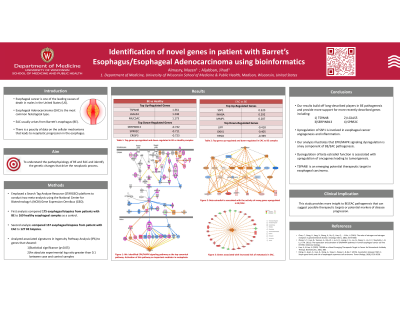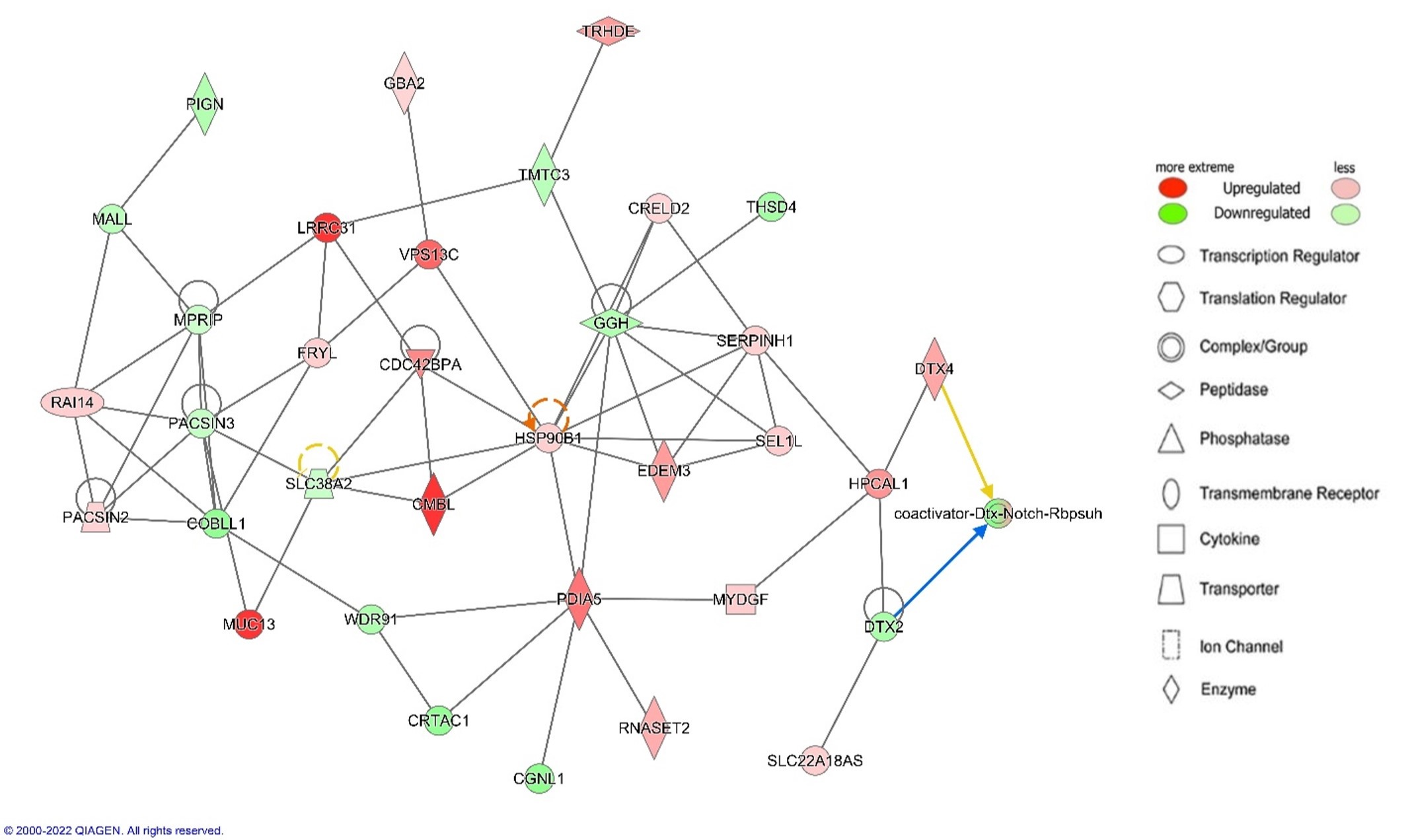Back


Poster Session B - Monday Morning
Category: Esophagus
B0215 - Identification of Novel Genes and Pathways in Barret’s Esophagus and Esophageal Adenocarcinoma Using Bioinformatics
Monday, October 24, 2022
10:00 AM – 12:00 PM ET
Location: Crown Ballroom

Has Audio

Mazen Almasry, MBBS
University of Wisconsin School of Medicine and Public Health
Madison, WI
Presenting Author(s)
Mazen Almasry, MBBS1, Jihad Aljabban, MD1, Maha Nassar, MBBS2, Maryam Panahiazar, PhD3
1University of Wisconsin School of Medicine and Public Health, Madison, WI; 2Alfaisal University College of Medicine, Riyadh, Ar Riyad, Saudi Arabia; 3University of California San Francisco, San Francisco, CA
Introduction: Esophageal cancer is one of the leading causes of death in males in the United States (US). Esophageal Adenocarcinoma (EAC) is the most common histological type. EAC usually arises from Barrett’s esophagus (BE). There is a paucity of data on the cellular mechanisms that leads to neoplastic progression in the esophagus.
Methods: We conducted two meta-analyses using our STARGEO platform to tag samples from Gene Expression Omnibus. One analysis compares 175 esophageal biopsies from patients with BE to 169 healthy esophageal samples as a control and the other compares 157 esophageal biopsies from patient with EAC to 127 BE biopsies. Results from the two meta-analyses were analyzed using Ingenuity Pathway Analysis.
Results: For the BE vs healthy tissue analysis, ERK/MAPK signaling and integrin signaling were found as top canonical pathways. The top upstream regulators included genes implicated in inflammation such as TNF and TGFB1. Additionally, results suggested possible causal role of Secreted Phosphoprotein 1 (SSP1) gene, which is essential in the pathway that leads to type I immunity, as well as ACP5 gene, a clinically relevant parameter of cancer progression/aggressiveness. Top upregulated genes hold implications in cell migration and invasion such as TSPAN8 and adherens junctions like LGALS4. Top downregulated genes largely held roles in epidermal differentiation complex including SERPINB13 and SPRR2C. Overall, our analysis reflected oncogenic changes seen in BE (Figure 1).
For the BE vs EAC analysis, Xenobiotic Metabolism PXR signaling pathway was the top canonical pathway. Similarly, the top upstream regulators also included genes implicated in inflammation such as IL1B and TGFB1. Also, ERBB2, a member of the epidermal growth factor receptors, was among the top upstream regulators. IL17-TH17 was reported to have a possible causal role in EAC. Top upregulated genes were oncogenes like IGF2BP3 and genes that belong to the GO groups extracellular region /matrix such as MMP1 and INHBA.
Discussion: : Our results build off long-described players in BE/EAC pathogenesis and provide more support for more recently described genes such as TSPAN8, LGALS4, SERPINB13, SPRR2C, etc. Additionally, SSP1, involved in cancer angiogenesis and inflammation, as well as IL17-TH17 were identified as possible causal networks. Overall, this study provides more insight to BE/EAC that can suggest possible therapeutic targets or potential markers of disease progression.

Disclosures:
Mazen Almasry, MBBS1, Jihad Aljabban, MD1, Maha Nassar, MBBS2, Maryam Panahiazar, PhD3. B0215 - Identification of Novel Genes and Pathways in Barret’s Esophagus and Esophageal Adenocarcinoma Using Bioinformatics, ACG 2022 Annual Scientific Meeting Abstracts. Charlotte, NC: American College of Gastroenterology.
1University of Wisconsin School of Medicine and Public Health, Madison, WI; 2Alfaisal University College of Medicine, Riyadh, Ar Riyad, Saudi Arabia; 3University of California San Francisco, San Francisco, CA
Introduction: Esophageal cancer is one of the leading causes of death in males in the United States (US). Esophageal Adenocarcinoma (EAC) is the most common histological type. EAC usually arises from Barrett’s esophagus (BE). There is a paucity of data on the cellular mechanisms that leads to neoplastic progression in the esophagus.
Methods: We conducted two meta-analyses using our STARGEO platform to tag samples from Gene Expression Omnibus. One analysis compares 175 esophageal biopsies from patients with BE to 169 healthy esophageal samples as a control and the other compares 157 esophageal biopsies from patient with EAC to 127 BE biopsies. Results from the two meta-analyses were analyzed using Ingenuity Pathway Analysis.
Results: For the BE vs healthy tissue analysis, ERK/MAPK signaling and integrin signaling were found as top canonical pathways. The top upstream regulators included genes implicated in inflammation such as TNF and TGFB1. Additionally, results suggested possible causal role of Secreted Phosphoprotein 1 (SSP1) gene, which is essential in the pathway that leads to type I immunity, as well as ACP5 gene, a clinically relevant parameter of cancer progression/aggressiveness. Top upregulated genes hold implications in cell migration and invasion such as TSPAN8 and adherens junctions like LGALS4. Top downregulated genes largely held roles in epidermal differentiation complex including SERPINB13 and SPRR2C. Overall, our analysis reflected oncogenic changes seen in BE (Figure 1).
For the BE vs EAC analysis, Xenobiotic Metabolism PXR signaling pathway was the top canonical pathway. Similarly, the top upstream regulators also included genes implicated in inflammation such as IL1B and TGFB1. Also, ERBB2, a member of the epidermal growth factor receptors, was among the top upstream regulators. IL17-TH17 was reported to have a possible causal role in EAC. Top upregulated genes were oncogenes like IGF2BP3 and genes that belong to the GO groups extracellular region /matrix such as MMP1 and INHBA.
Discussion: : Our results build off long-described players in BE/EAC pathogenesis and provide more support for more recently described genes such as TSPAN8, LGALS4, SERPINB13, SPRR2C, etc. Additionally, SSP1, involved in cancer angiogenesis and inflammation, as well as IL17-TH17 were identified as possible causal networks. Overall, this study provides more insight to BE/EAC that can suggest possible therapeutic targets or potential markers of disease progression.

Figure: Top network (Cancer, Cellular Compromise, and Cellular Function and Maintenance) identified by IPA Network analysis of Barrett’s esophagus. Legend illustrates class of the gene. Red indicates upregulation and green downregulation, with shade depicting magnitude of change. Solid and dashed lines depict direct and indirect, respectively, relationship between genes.
Disclosures:
Mazen Almasry indicated no relevant financial relationships.
Jihad Aljabban indicated no relevant financial relationships.
Maha Nassar indicated no relevant financial relationships.
Maryam Panahiazar indicated no relevant financial relationships.
Mazen Almasry, MBBS1, Jihad Aljabban, MD1, Maha Nassar, MBBS2, Maryam Panahiazar, PhD3. B0215 - Identification of Novel Genes and Pathways in Barret’s Esophagus and Esophageal Adenocarcinoma Using Bioinformatics, ACG 2022 Annual Scientific Meeting Abstracts. Charlotte, NC: American College of Gastroenterology.

